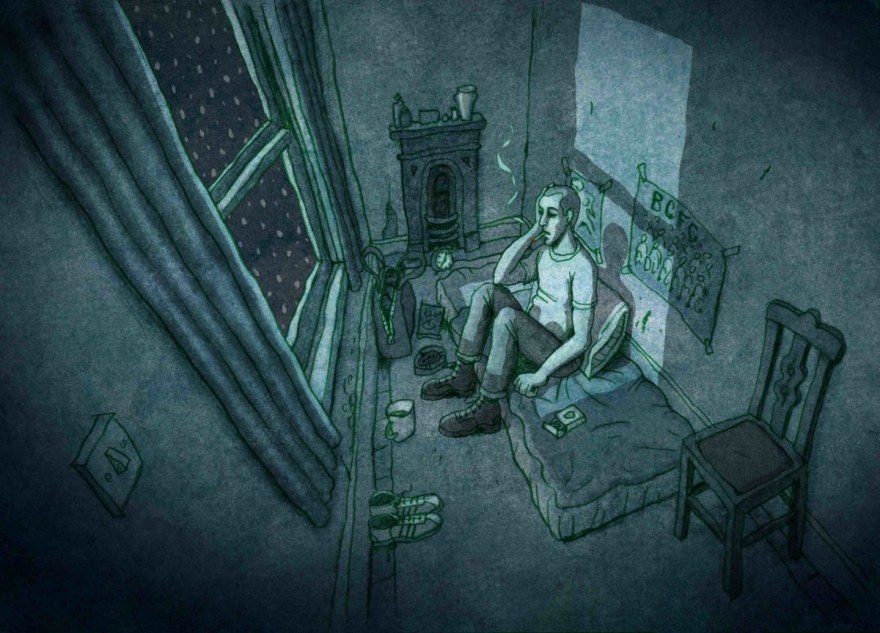Tea time with Roughhouse
An interview with Jonathan Hodgson, director of Roughhouse
Are there any elements of this story that are autobiographical? Are the friends based on people you know?
The story is inspired by an episode from my late teens when I was living in a student flat in Liverpool. Some of the characters are based on people I knew at the time, although I have changed the names and appearance so that no one is identifiable. I have also altered a lot of the physical locations and story events, but the psychological journey is much the same. We were all good friends at first, but a problem arose when one member of the household couldn’t pay the rent and seemed quite happy to let the rest of us to pay his share and do nothing in return. We were young and naive and didn’t know how to resolve things in a mature way so things soon got very out of hand.
Why did you choose these setting and time?
I prefer to make films about things I know about, rather than making up fantasies. I could have set the story in a different place and time, but there didn’t seem much point when I could make a more interesting and authentic narrative by visually recreating a place and time that I had direct experience of and which had made a very strong impression on me.
Can you tell us a bit about your animation style? What are your influences or inspirations?
The look of the film is largely inspired by the drawings and paintings I was producing as an art student in the late 70s, when I was particularly influenced by German Expressionism. I still have a lot of the artwork from that time lying around and I was interested in recycling it and giving it a second life. The style of the animation bears more than a passing resemblance to this artwork, although it was unfeasible to use analogue artworking techniques. Instead I relied heavily on digital software such as TV Paint, Photoshop and After Effects. For the colour I was inspired by printmaking techniques such as screen printing and lithography that use a limited range of transparent colours, where two colours might be overlaid to create a third. Most of the scenes have a unique palette based on two colours such as green and red or orange and blue. The choice of colour reflects the emotional content of the scene so that happier scenes have stronger, warmer colours, while the unhappier sections tend to have cooler and more muted colours. The one exception to this rule is the party scene, which borrows from the colour palette of my student film Nightclub, which was painted with food colouring, because at the time I couldn’t afford to buy coloured inks.The story of Roughhouse is very dialogue-driven with a lot of lip-synch so it needed a more traditional animation technique than some of my other films. I was working with a team of animators from Studio Train-Train so the animation had to be much more carefully planned out. For instance, the characters had to be fully developed at the preproduction stage to help the animators understand who each character was, whereas if I had been doing all the animation myself I would probably have been more spontaneous and made everything up as I went along.
How did you end up making films with both French and British partners?
For the last 20 years, funding for short animation has been virtually non-existent in the UK. There are a few schemes offering small amounts of money, which I applied for, but I was unsuccessful so I initially decided to fund the film myself. I worked on the film on and off for a few years, but it was always on the back burner and didn’t progress very far. While attending a European animation festival I noticed that many of the films had French funding so I decided to try and find a French producer. I made contact with Olivier Catherin and eventually he passed my proposal on to Richard Van Den Boom at Papy3D Productions who became the French producer of the film. As I had already spent a lot of time developing the film prior to securing French funding, we agreed that the film should be an English/French co-production with my own company Hodgson Films coming in as the UK producer.
Would you say that the short film format has given you any particular freedom?
I tend to make very personal films and I prefer working with the short animation format, which allows me more freedom of expression as a director. A longer length film will require a bigger budget and inevitably more people will want to have a say in the creative process. Also when making a short film you can usually be much looser and more experimental with the technique and narrative. The longer the film, the more you need to concern yourself with traditional filmmaking conventions such as story structure and character development and the visual treatment might need to be more refined to avoid mentally fatiguing your audience, whereas with a short film you can be as rough and expressive as you like.
Roughhouse was shown in International Competition.








